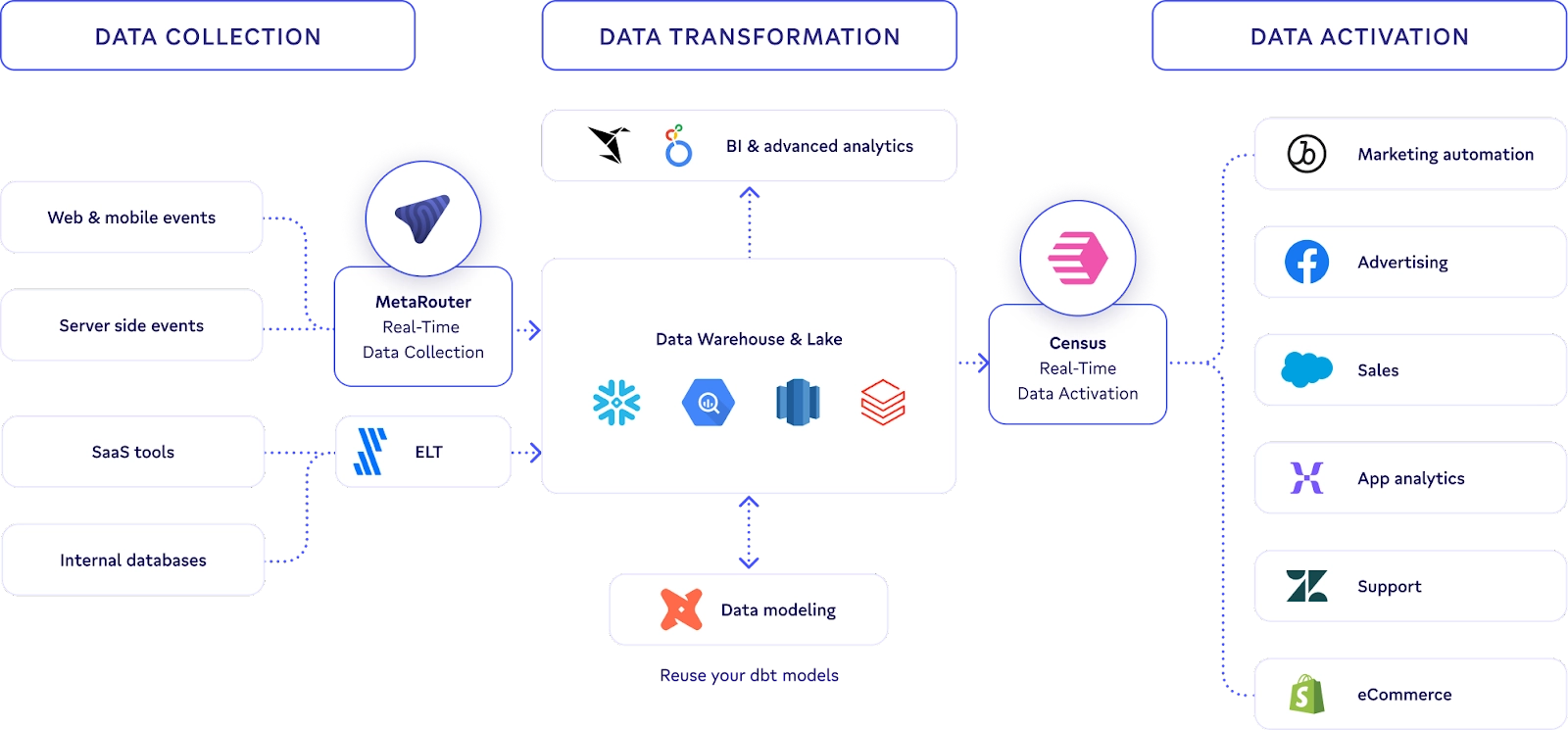Remember when the days of "Dear [First Name]" emails felt like cutting-edge personalization?
We’ve come a long way since then. Today, customers demand deeper personalization tailored to their individual preferences, purchase history, and online behavior.
Technology evolves, paradigms shift, and so should every retailer’s data strategy – it's time to enter the era of real-time personalization.
Recent groundbreaking advancements in data technology have now made it possible for retail brands to collect, unify, and activate vast amounts of data in real time, empowering them to make decisions and deliver customer experiences with unprecedented speed and accuracy.
In this blog, we’ll dive into the latest innovations in retail data platforms, how to decide which use cases need to be in real time, and how to get up and running with a real-time data stack.
The evolution of customer data technology for retail
Retail brands have always struggled with creating a single view of their customer because they possess too much data, stored in too many different places, coming from a multitude of channels.
Growing customer expectations and retail brands’ fundamental need to consolidate customer data into a single view have been driving two decades of technological advancement. We’re now at the cusp of a paradigm shift in customer data management that has the potential to unlock every retail use case imaginable.
Let’s start with a brief history of retail data:
Big data
Going back to the 2000s, “big data” was the phrase of the decade when retailers became overwhelmed by an explosion of customer data coming from new digital channels like social media and advertising networks. During that time, the belief was that collecting as much data as possible would somehow lead to better customer experiences.
However, retailers quickly realized that simply having data wasn’t enough. They needed to actually put their goldmine of customer insights into the hands of marketing and advertising teams to deliver personalization at scale, omnichannel campaigns, and ads optimization.
Customer Data Platforms (CDPs)
CRMs like Salesforce and HubSpot helped businesses organize their data, but they were designed for B2B organizations and not B2C brands. Nevertheless, they paved the way for Customer Data Platforms (CDPs), which were invented to specifically help marketers unify their siloed data across martech tools. CDPs were gamechangers that gave marketers new capabilities for event collection, customer profile management, and segmentation, but they soon ran into limitations because they couldn’t scale to handle extremely large volumes of customer data.
Similarly, in adtech, Data Management Platforms (DMPs) reached a peak in the 2010s, but have now been phased out. DMPs were invented to help advertisers unify third-party customer signals (often collected without a person's permission), but the death of third-party cookies and increased focus on first-party data have rendered DMPs extinct.
2020s: Cloud data warehouses and the Modern Data Stack
Most recently, cloud data warehouses and data lakes like Snowflake, Google BigQuery, and Databricks have emerged as leaders in customer data technology. Their advantage over CRMs and CDPs is their virtually unlimited and cost-effective storage and computing power, which is essential to help retail brands harmonize their customer data and power BI and analytics.
 |
The foundation of successful data activation starts with a robust data collection solution like MetaRouter that is compliant by default, ensuring that businesses have high-quality, secure data from the start to drive meaningful insights and personalized customer experiences in every downstream system.
In the center, customer data is unified in the cloud data warehouse or lakehouse, leading to the most complete and accurate Customer 360 profiles. Today, every cutting-edge retailer has adopted this “warehouse-native” retail data stack to transform their customer data strategy. For example, Home Depot, Pepsi, Target, Macy’s, Sonos, and Doordash all rely on their warehouse to unify customer information from physical and digital sources.
The last mile of the data stack is a Data Activation tool like Census that helps retailers connect data to marketing operations to power more personalized campaigns in business tools like Braze, Google Ads, Salesforce, HubSpot, and Zendesk.
2024 and Beyond: Real-time data for all retail use cases 🚀
Until very recently, one drawback of data warehouses was that they were slow. They were originally designed for accuracy and power, not speed, meaning that they weren’t capable of real time use cases like cart abandonment, geotargeting, and inventory management that require blazing fast activation.
Recent breakthroughs in customer data technology by Census and MetaRouter overcame this barrier. It’s now possible for retailers to harness their data warehouse insights to power real time campaigns, which was virtually impossible just months ago. This will transform the way brands unlock new revenue streams, enhance customer experiences, and stay ahead of the competition.
From real-time web and app personalization that cater to individual customer preferences, to dynamic inventory management that syncs across systems, real-time use cases are enhanced by fresh, complete, and trustworthy data in the warehouse.
The best part about this modern retail data stack? No more data silos, CSV uploads, or 12-month engineering cycles needed.
Beyond the hype: Harnessing the power of real time effectively
Technology has finally caught up with the vision, but navigating implementation requires strategic consideration. Making data faster isn't just about slapping a "real time" label on everything. It's about knowing where it actually adds value.
Think about it. Is 15-minute data "good enough"? Maybe, or maybe not. Could you capture more demand, personalize offers more effectively, or improve revenue with sub-second latency? Imagine the experience you'd demand as a consumer – smooth, personalized, and immediate. Now, translate that into what your customers crave.
Retail, for example, thrives on speed. The "next page," the next session, and Next Best Action – these high-value use cases can make or break your game. Why keep serving ads to converted customers? Leverage real-time data to optimize ROAS by targeting new prospects. But does this need to be an action within 10 seconds? Maybe, maybe not. Every use case has its latency sweet spot. Some situations don't require instant data – a monthly sales report, for example.
The key is to identify areas where lower latency can create a tangible return on investment. Could capturing demand within seconds instead of minutes boost your revenue? Analyze the potential gains and weigh them against the implementation costs.
Put yourself in your customers' shoes. Imagine an ad popping up for a product you just viewed, or receiving personalized support during a tech issue – all in real-time. That's the art of the possible, and it's not just about fancy tech; it's about understanding customer needs and expectations.
Real-time use cases for Retail
Although not every use case needs to be truly real time (aka seconds), new shopping trends such as live commerce on social platforms and AI-generated fashion push retail brands to innovate at speed and scale, making them among the most sophisticated in real-time adoption.
Retail and eCommerce companies are also under immense pressure to reduce costs, improve customer experience, and keep customer retention and revenue high.
Here are some retail use cases that can benefit from the fastest and freshest data:
Real-time inventory management — Retailers like Walmart need to closely optimize their inventory to maximize revenue and prevent dissatisfied customers. When customers order, it’s important to immediately identify out-of-stock items, send accurate shipping estimates to customers, and place fulfillment orders with suppliers, all within seconds. This efficiency is crucial for retailers, especially when managing inventory across multiple distributors, stores, and sales channels.
Push notifications — Related to the first example, when an item is back in stock, retailers can use real-time data from their inventory management system to reengage customers with personalized in-stock notifications. Check out this example of how an eCommerce store can easily set up a real-time data stack to send instant push notifications:
Customer loyalty — How do you retain a customer that had a bad experience, like spiders in their mascara?! Based on research by Uber, brands can reverse bad customer experiences by sending an apology message and a small gift, like a $5 coupon. It’s important to address their concerns ASAP and personalize outreach with information like their ticket number, lifetime spend, etc.
Geo-targeted campaigns — When a customer enters a geographic area, like a physical store, sporting arena, or airport, retailers like Starbucks can trigger targeted campaigns in minutes. For example, Starbucks may want to re-engage customers who haven’t made a purchase in the last 60 days. They can send a 20% off coupon in the Starbucks app for customers within 5 miles of any store to incentivize them to return.
Cart abandonment — When an ecommerce customer has items in their cart and leaves the site or becomes inactive, brands like Nike can recover abandoned transactions by reminding them of their items and encouraging them to complete their purchase. Reaching out immediately through email, SMS, or ad retargeting (combined with customer information in the warehouse) can recover lost transactions at least 29% of the time.
Why is this real-time approach so important?
- Speed is king: Traditional batch processing prioritizes data quality over speed, limiting insights and reaction times. Real-time data streams provide immediate understanding, allowing you to act on trends as they unfold. Imagine detecting fraudulent transactions instantly or personalizing offers based on real-time customer behavior.
- Proactive instead of reactive: Businesses are no longer passive observers. Real-time data empowers them to anticipate issues, predict trends, and make preventative decisions. Think of next-page personalization adjusting content based on real-time clicks, or discount offers being optimized based on item demand.
- Enhanced customer experience: Imagine receiving curated recommendations after you add an item to your cart, or getting immediate support during a mobile app issue. Real-time data streams allow brands to understand and cater to individual needs in real-time, fostering engagement and satisfaction.
Get Started with Real-Time Data Collection
Real-time success relies on having data that can be used as soon as it happens. This means that you need a data collection tool that can collect and deliver real-time data streams while ensuring it's clean, accurate, consistent, and compliant through robust data governance and quality checks. Remember, garbage in, garbage out. Invest in infrastructure that can handle high volumes and low latency.
Think of it like a live feed, constantly transmitting data as it's generated. This is in contrast to traditional data collection methods, which involve collecting data at regular intervals, such as once a day.
Real-time data collection can be used to track a variety of metrics, including website traffic, user behavior, and sales transactions. This data can be used to gain insights into customer behavior, identify trends, and make informed decisions about how to improve the customer experience and increase sales.
Get Started with Real-Time Data Activation
To transform all your valuable insights to action, you need a way to connect customer data to marketing tools like Braze, Iterable, Google Ads, and Facebook Ads in real time.
At Census, we were the first to pioneer real-time activation on the cloud data warehouse. Our Live Syncs enable retail brands to interact with customers at the moment of intent, deliver the most personalized recommendations, and update AI models with the freshest insights.
It’s easier than ever for any marketing or advertising team to unleash the power of their cloud data and build real-time campaigns. We’d love to show you how to get started — sign up for a retail demo or start a 14-day free trial now.


















